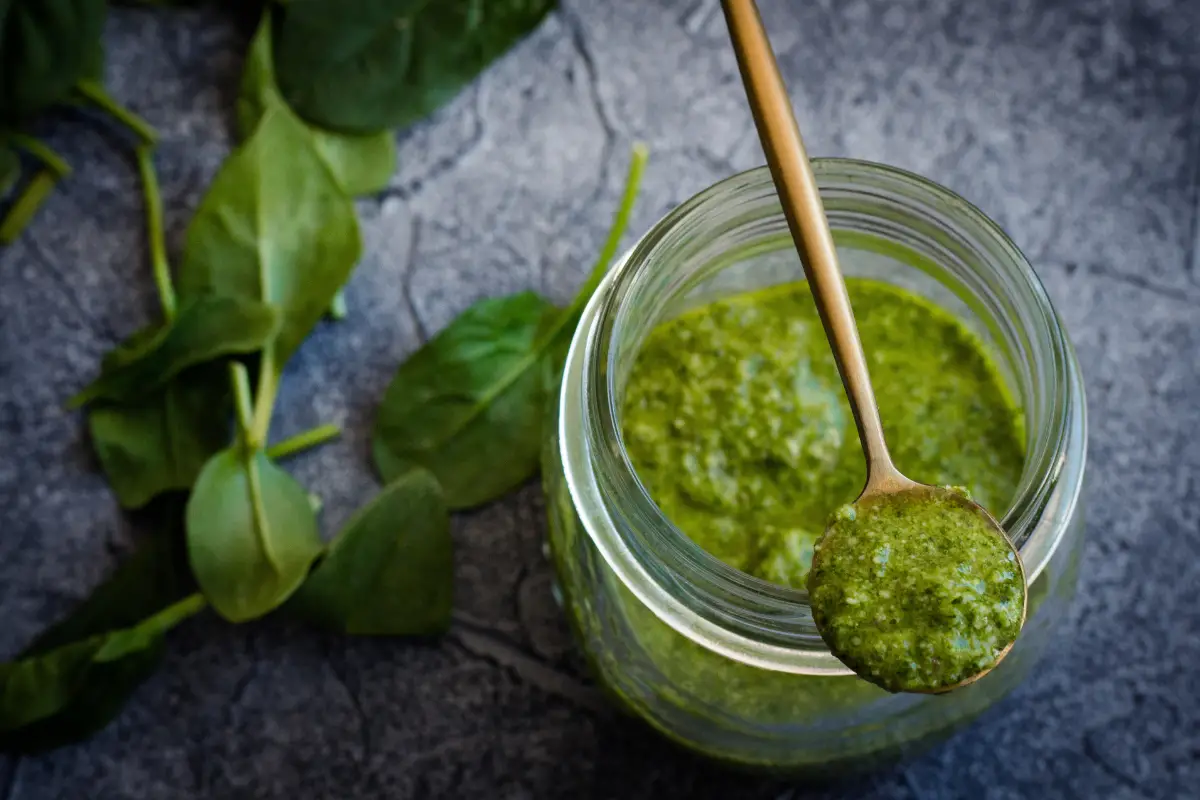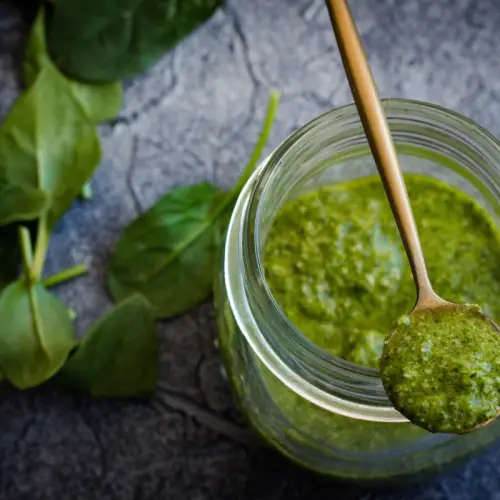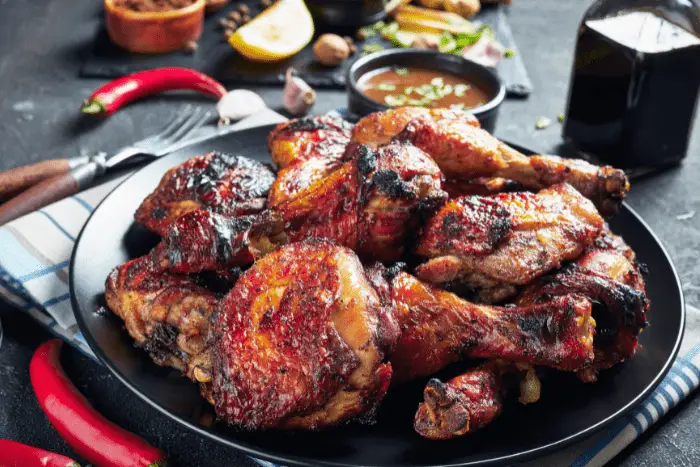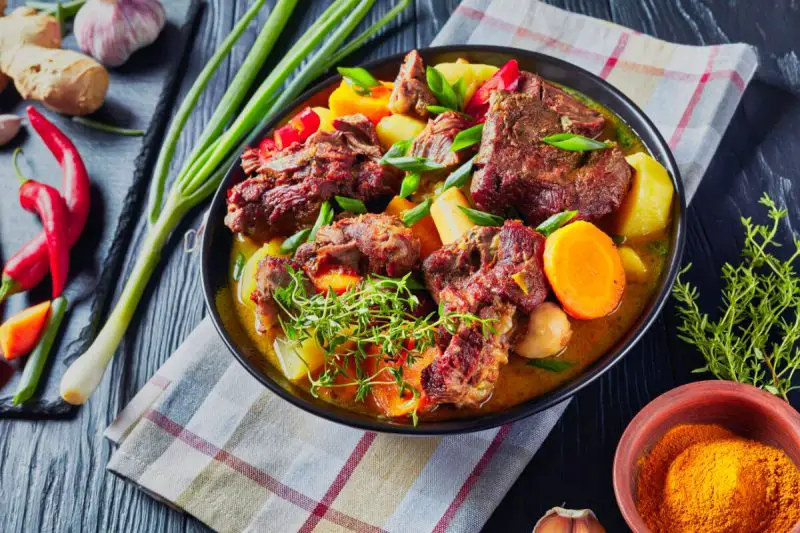
The page features the Haitian Epis recipe, a traditional Caribbean seasoning base used in Haitian cooking. The paste is composed of peppers, fresh herbs, garlic, olive oil, and vinegar.
Want more ideas to round-out your Haitian Recipe Box?
A lot of great options are in these posts!
Commonly used in a variety of savory dishes, the spicy Epis is vegan, gluten-free, and can be made within 10 minutes using a food processor. The seasoning can be stored in an air-tight container or frozen for later use.
You May Want to Join The World Recipes With Our Big Escape
Share your own recipes in our Facebook Group. Find recipes from all over the world. Learn more about International Cuisine and how you can surprise your family with new and exciting foods from all over the world.
For More Photos Visit Our Instagram at World Recipes Daily
Haitian Epis is a widely used flavor base in Haitian cuisine. Its recipe varies, but usually includes peppers, garlic, and herbs. Commonly used in dishes like rice and beans, stews, and soups, it’s also a marinade for meats and fish.
With Taino and African origins, it’s similar to Sofrito in Hispanic cooking. Traditionally made with a wooden mortar and pestle, blenders are now common for making Epis. Sometimes called a pesto sauce, such bases are popular in Caribbean cooking. Try our Haitian epis recipe.
Epis celebrates this dynamic past by fusing native ingredients like Scotch bonnet peppers with European and African spices like thyme and cloves to create a symphony of flavors that captures the global spirit of Haiti.
Want more ideas to round-out your Caribbean Recipe Box?
A lot of great options are in these posts!
Typically, fresh vegetables, herbs, and spices like onions, garlic, bell peppers, Scotch bonnet peppers, thyme, parsley, and cloves are blended or finely chopped together to make epis. Blended with oil or vinegar, the combination becomes a paste or sauce that may be used in a wide variety of meals.
The Haitian Epis recipe provides you with a versatile and flexible spice mix since its specific components and quantities can vary according to regional and individual tastes.
As a condiment or dipping sauce, Epis adds a blast of flavor to complement and improve the taste of a wide variety of foods, and it may also be used as a spice for cooked items.
The Haitian Epis is an essential part of Haitian cuisine because to its robust flavor and adaptability. Its unique combination of culinary influences has formed Haitian gastronomic traditions over time, and its origins are firmly anchored in the nation’s rich and diverse past.
3 Reasons People Love the Haitian Epis Recipe
1. Versatility and Adaptability: The exceptional versatility and adaptability of the Haitian Epis seasoning is one of the main reasons it is so well-liked. The herbs, spices, and vegetables that go into Epis can be adjusted to suit personal tastes, regional preferences, or the meal being served.
Its versatility makes it great for use in a variety of different ways in the kitchen, from marinating meats, poultry, and shellfish to flavoring stews, soups, and rice dishes.
2. Unique Flavor Profile: The distinctive and nuanced flavor of the Haitian Epis recipe is another of the its many appealing qualities. Haiti’s diverse cultural heritage is reflected in its spice blend, which draws inspiration from West African, Taino, Spanish, and French cooking styles.
The Scotch bonnet peppers and thyme and cloves that were brought in from abroad form a fragrant and flavorful blend that is representative of the country’s multiethnic heritage.
3. Connection to Haitian Culinary Heritage: The third appealing quality of the Haitian Epis recipe is its deep roots in the country’s culinary history. Epis is a staple in Haitian cooking and a window into the country’s history, customs, and cultural influences.
Reflecting the resourcefulness and ingenuity of the Haitian people, the seasoning mix is the result of a dynamic blending of ingredients and methods from other civilizations.

How To Make Our Haitian Epis Recipe
Ingredients: (8 servings)
1 bunch parsley, stems removed
1 bunch cilantro, stems removed
1 green bell pepper, chopped
1 red bell pepper, chopped
1 onion, chopped
4 garlic cloves, peeled
2 scallions, chopped
1 tbsp fresh thyme leaves
1 tbsp fresh oregano leaves
1 tsp salt
1 tsp black pepper
1/4 cup olive oil
1/4 cup white vinegar
1 tbsp lime juice
Instructions:
1. Wash and dry the parsley and cilantro, then remove the stems.
2. Roughly chop the parsley, cilantro, green and red bell peppers, onion, garlic, and scallions.
3. Place all the chopped ingredients in a food processor or blender.
4. Add the fresh thyme leaves, oregano leaves, salt, black pepper, olive oil, white vinegar, and lime juice.
5. Pulse or blend until all the ingredients are well combined and the mixture is smooth.
6. Taste and adjust seasoning as needed.
7. Store the Epis seasoning in an airtight container in the refrigerator for up to 2 weeks.
Nutritional Information For the Haitian Epis Recipe
Calories: 70
Carbohydrates: 5g
Protein: 1g
Fat: 6g
Saturated Fat: 1g
Cholesterol: 0mg
Sodium: 304mg
Potassium: 151mg
Fiber: 1g
Sugar: 2g
Prep Time: 15-20 minutes
Cooking Time: N/A (This recipe does not require cooking.)
Pots, Pans, and Cooking Equipment Needed for the Haitian Epis Recipe
Cutting board and knife
Food processor or blender
Measuring cups and spoons
Best Way to Store the Haitian Epis Recipe
The best way to store leftover Haitian Epis seasoning is to transfer it to an airtight container and store it in the refrigerator for up to 2 weeks.
Possible Substitutions For the Haitian Epis Recipe
You can substitute the white vinegar with apple cider vinegar or lime juice.
If you don’t have fresh herbs, you can use dried herbs instead, but use half the amount.
You can omit the scallions or replace them with chives or shallots.
Possible Substitutions for Ingredients For A Vegetarian Haitian Epis Recipe
This recipe is already vegetarian.
Tips and Tricks for Easier Creation
Use fresh ingredients for the best flavor.
Adjust the seasoning to your taste preference.
You can freeze the Haitian Epis seasoning in an ice cube tray and thaw as needed.
Possible Side Dishes and Desserts to Serve With the Haitian Epis Recipe
Haitian Epis seasoning can be used in a variety of Haitian dishes, including stews, rice and bean dishes, and grilled meats. Some popular side dishes include plantains, yams, and avocado salad.
How To Serve the Haitian Epis Recipe
Haitian Epis seasoning is a versatile ingredient that can be used in a variety of dishes. Add a spoonful to your favorite Haitian dish for an extra burst of flavor, or use it as a marinade for grilled meats or vegetables.
FAQs About the Haitian Epis Recipe
What is Haitian Epis seasoning?
Haitian Epis seasoning is a flavorful mixture of herbs, spices, and aromatics used as a base in many Haitian dishes.
Can I use dried herbs instead of fresh herbs?
Yes, you can use dried herbs in the recipe, but use half the amount of fresh herbs called for in the recipe.
How long does Haitian Epis seasoning last?
Haitian Epis seasoning can be stored in an airtight container in the refrigerator for up to 2 weeks or frozen for up to 3 months.
Can I make a smaller or larger batch of Haitian Epis seasoning?
Yes, you can adjust the quantities of the ingredients to make a smaller or larger batch of Haitian Epis seasoning.
What dishes can I use Haitian Epis seasoning in?
Haitian Epis seasoning is a versatile ingredient that can be used in many Haitian dishes, including stews, rice and bean dishes, and grilled meats or vegetables.
Final Thoughts
The people of Haiti and the rest of the globe have fallen in love with the varied, tasty, and deeply meaningful seasoning combination that is the Haitian Epis recipe.
Haitian cuisine is widely sought after by gourmets due to its unusual and complex taste profile, the result of a unique blend of herbs, spices, and vegetables that reflects the rich historical and cultural influences that have influenced it.
Epis’ amazing versatility and adaptability contribute to its global appeal, as the seasoning blend can be tailored to meet the needs of individuals, regions, and foods.
Because of its versatility, Epis is used in a wide variety of meals, from marinating meats, poultry, and shellfish to flavoring stews, soups, and rice.
The Haitian Epis recipe has the capacity to raise the flavor and complexity of meals from a variety of culinary traditions by enhancing and complementing a wide range of tastes is a testament to the potency of a well-crafted spice mix.
Haitian Epis widespread acclaim can be attributed, in part, to the dish’s diverse taste profile, which captures the cosmopolitan spirit of Haiti’s cuisine. People’s tastebuds will be captivated by the fragrant and flavorful blend of locally sourced ingredients and foreign herbs and spices.
The Haitian Epis recipe is a popular spice mix among foodies who want to experience the full range of flavors that Haiti has to offer because of its depth and richness.
The fact that Epis is inextricably linked to Haitian culinary history makes it all the more appealing; the spice mix is a concrete representation of Haiti’s long and varied cultural past.
Epis frequent appearance in both ordinary and celebratory meals serves as a reminder of the value of holding on to and honoring one’s culinary traditions as a method of sustaining one’s culture and bringing people together.
As curiosity about Haitian food spreads throughout the world, one dish that represents the ingenuity and resourcefulness of the Haitian people is Epis.
The popularity of Haitian Epis throughout the years is evidence of the way in which cuisine can bring people together regardless of their origins or beliefs by uniting them over a common love of good taste.
In conclusion, the Haitian seasoning mix known as Epis is fundamental to Haitian cuisine because of its deliciousness, adaptability, and cultural significance.
Because of its singular blend of tastes, versatility, and association with Haitian cuisine, it has won the hearts of cooks all over the world and become an indispensable ingredient.
Spicy Hot Haitian Epis Sauce
Equipment
- Cutting board and knife
- Food processor or blender
- Measuring cups and spoons
Ingredients
- 1 bunch parsley, stems removed
- 1 bunch cilantro, stems removed
- 1 green bell pepper, chopped
- 1 red bell pepper, chopped
- 1 onion, chopped
- 4 garlic cloves, peeled
- 2 scallions, chopped
- 1 tbsp fresh thyme leaves
- 1 tbsp fresh oregano leaves
- 1 tsp salt
- 1 tsp black pepper
- 1/4 cup olive oil
- 1/4 cup white vinegar
- 1 tbsp lime juice
Instructions
- Wash and dry the parsley and cilantro, then remove the stems.
- Roughly chop the parsley, cilantro, green and red bell peppers, onion, garlic, and scallions.
- Place all the chopped ingredients in a food processor or blender.
- Add the fresh thyme leaves, oregano leaves, salt, black pepper, olive oil, white vinegar, and lime juice.
- Pulse or blend until all the ingredients are well combined and the mixture is smooth.
- Taste and adjust seasoning as needed.
- Store the Epis seasoning in an airtight container in the refrigerator for up to 2 weeks.


